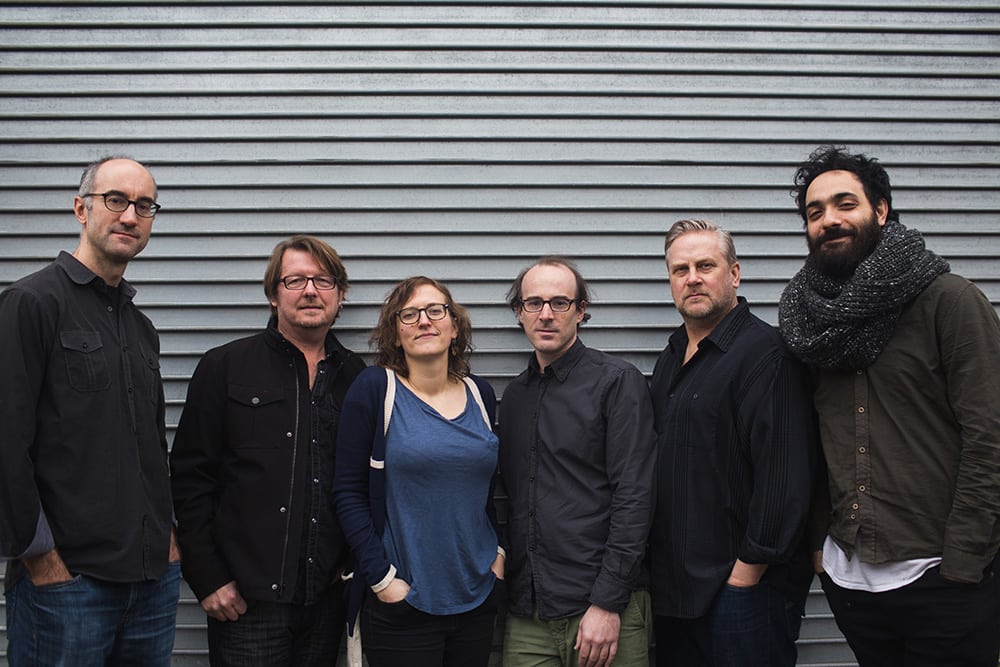Review by Megan Parsell, Special to the Sybaritic Singer
Ken Thomson is a well-known musician and composer from Bang on a Can All-Stars and Gutbucket, as well as the musical director for Asphalt Orchestra. In addition to those roles, he has been commissioned by the American Composers Orchestra and received awards for his compositions from New Music USA, ASCAP and Meet the Composer. As a composer and performer, Thomson’s music is heavily set in connecting the genres of contemporary music and jazz. He achieves this goal by pairing the complexities of these two types of music through the use of form, harmony and rhythmic intricacies. Thomson’s latest album, “Sextet” is a brilliant example of how these two seemingly different genres can play nice together.
A great contribution to the success of Thomson’s composition “Sextet” is his use of musicians well-versed in the mediums of both composing and improvising. The members of the ensemble on this album include the composer, Ken Thomson, alto saxophone; Anna Weber, tenor saxophone; Russ Johnson, trumpet; Alan Ferber, trombone; Adam Armstrong, bass; and Daniel Dor, drums. Each of these musicians adds their own special layer to the overall success of the album through their deep understanding of improvisation and composition. The music composed by Thomson is exceptional in the fact that its difficulty does not hinder the high level of musicianship as displayed throughout the album. The musicians on this album effectively bring the music to life with their performance.
The first movement, “Passacaglia Ungherese” is a five-minute cyclical rendition based on a 1978 harpsichord passacaglia, however the parts are split between four horns. This opening track sets the album apart from others with a composition that immediately sets the listener up to question why a jazz album would begin with something that is closer to a classical medium rather than the jazz genre. The choice to use a prelude with intricate counterpoint was an excellent way to introduce this album and to get the listener thinking, “what is this about, and how will it affect the entirety of the album?” Thelonious Monk used a similar approach where he opened an album using a chorale. The opening track on an album creates an expectation and Thomson’s approach is well-executed by creating a sound world that sets itself apart from others.
A prime example of the way that Thomson incorporates these two styles into one happens on the fifth track on the album, “Helpless”. This track bridges the gap between jazz and contemporary music through creating an underlying idea that sounds minimalistic in nature while simultaneously allowing an improvisatory solo to take place above the rest of the ensemble. The focus of the first two minutes of this track can be separated into two groups, the first being the improvisatory trumpet melody, and the second group being the hemiola created within the ensemble. The foundation of the hemiola is used within a small range of pitches and mainly focuses on putting duple and triple rhythms together to create a blurred sound world that does not take away from the melodic idea shaped by the trumpet.
A central theme throughout “Sextet” is the use of repetition. The way in which Thomson uses repetition reminds one of the characteristic style of minimalist composer Philip Glass, and something that is clearly heard on every track in this album. Repetition is a common occurrence in pitch material, timbre, and dynamic variation; however, the most prominent repetition can be heard within the rhythm. The rhythmic material used in each track creates a groove that even the most complex compositional ideas can fall into. The second track “Misery Is Our New Hope” uses both melodic and rhythmic repetition as a means to create energy and excitement as the album progresses. The first minute of this track is consumed in repetitive melodic idea that is seamlessly passed between different voice pairings before leading directly into a lengthy saxophone solo. As the saxophone solo is winding down the music comes back to the initial theme of the track before leading into a trumpet solo. Succeeding the trumpet solo is a return of the driving melody that adds new voices and additional layers to the original theme to create a great deal of tension before falling into line with all of the voices and ending together.
The final track, “Phantom Vibration Syndrome” has components of each compositional technique used throughout the album compiled into one. This includes the heavy use of melodic and rhythmic repetition, seventh chords paired with many moments of tasteful dissonance and extended solos throughout this nine minute track to encapsulate the compositional style used through the entirety of the album. The construction of the counterpoint allows for the moments of dissonance to flourish in a logical sequence as it allows the listener to focus on the melodic lines separately and understand the moments of dissonance as the lines lead into each other.
“Sextet” is a superb demonstration of fusing the worlds of jazz and contemporary music together as one. With its unique beginning and contrasting styles, Ken Thomson has proven that he can meld these genres together to create something truly unique. The demanding and technical abilities required throughout the album are handled effortlessly by the ensemble, providing an engaging experience throughout. Whether you are a jazz musician or a contemporary enthusiast, Thomson’s “Sextet” shows that these two genres not only play nice together, but sound great together.
 Megan Parsell is a saxophonist and composer based in Ann Arbor, MI. In 2016, she graduated from Adrian College, where she studied saxophone with Professor Shannon Ford. In 2018, She completed graduate studies at Wayne State University earning a Master of Music in Saxophone Performance. During her time at Wayne State, she studied with saxophonist Dr. Matthew Younglove, performed with the WSU Wind Symphony, played tenor saxophone in Concinnity Quartet, and was a staff member for the Warrior Marching Band. She has performed at events such as the International Saxophone Symposium hosted by the Navy Band, Dakota Chamber Music and the American Saxophone Academy. As a new music enthusiast, she has premiered pieces by Joo Won Park and Peter Ford. In addition to her performance opportunities, she has been involved with many marching bands throughout Michigan and Ohio, as well as preparing students for MSBOA band festival as a clinician. She currently is an instructor at Expressions Music Academy, as well as a freelance musician and teacher.
Megan Parsell is a saxophonist and composer based in Ann Arbor, MI. In 2016, she graduated from Adrian College, where she studied saxophone with Professor Shannon Ford. In 2018, She completed graduate studies at Wayne State University earning a Master of Music in Saxophone Performance. During her time at Wayne State, she studied with saxophonist Dr. Matthew Younglove, performed with the WSU Wind Symphony, played tenor saxophone in Concinnity Quartet, and was a staff member for the Warrior Marching Band. She has performed at events such as the International Saxophone Symposium hosted by the Navy Band, Dakota Chamber Music and the American Saxophone Academy. As a new music enthusiast, she has premiered pieces by Joo Won Park and Peter Ford. In addition to her performance opportunities, she has been involved with many marching bands throughout Michigan and Ohio, as well as preparing students for MSBOA band festival as a clinician. She currently is an instructor at Expressions Music Academy, as well as a freelance musician and teacher.

